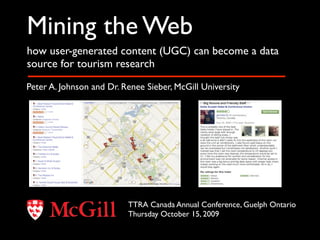Mining the Web: How user-generated content can become a data source for tourism research
- 1. Mining the Web how user-generated content (UGC) can become a data source for tourism research Peter A. Johnson and Dr. Renee Sieber, McGill University TTRA Canada Annual Conference, Guelph Ontario Thursday October 15, 2009
- 2. Outline ŌĆó What is user generated content (UGC)? ŌĆó Examples of tourism-related UGC ŌĆó Tripadvisor study ŌĆó Challenges to UGC
- 3. What is UGC?
- 4. ŌĆó User-generated content is: ŌĆó content made publicly available over the Internet ŌĆó re’¼éects creative effort ŌĆó created outside of professional routines and practices (OECD, 2007) http://www.oecd.org/dataoecd/57/14/38393115.pdf
- 9. Tripadvisor study ŌĆó A popular travel rating site ŌĆó Determine the range and nature of reviews of Nova Scotia ŌĆó Start search queries using ŌĆ£nova scotiaŌĆØ and ŌĆ£halifax nova scotiaŌĆØ ŌĆó Web scrape as many reviews as possible
- 10. Web Scraping ŌĆó Specialized computer software (robot or spider) ŌĆó Automated extraction of website data ŌĆó Simulates ŌĆ£clicksŌĆØ to drill down through a web page ŌĆó Outputs thousands of records in hours
- 23. 5730 total reviews 5000 4064 3750 2500 1513 1250 153 0 Attractions Restaurants Accommodations Reviews
- 25. Survey vs. UGC Survey UGC Sample Controlled Uncontrolled Type Question Open/Close Generally Type Ended Open-Ended Research Investigative Exploratory Approach
- 28. Attraction Reviews activity
- 30. Total Destination Review Breakdown Halifax Annapolis Royal Baddeck Lunenburg Dartmouth Yarmouth 33% Digby 40% Other 3% 4% 4% 6% 5% 5%
- 31. Accommodation Review Ratings One Star Two Stars Three Stars Four Stars 7% Five Stars 8% 10% 53% 22%
- 32. Attraction Review Ratings One Star Two Stars Three Stars Four Stars 7% 5% Five Stars 9% 56% 23%
- 33. Restaurant Review Ratings One Star Two Stars Three Stars Four Stars 7% Five Stars 8% 37% 17% 32%
- 34. Challenges with UGC ŌĆó Quality varies widely ŌĆó Vendetta/self promotion ŌĆó Legal grey area ŌĆó Generalizability?
- 35. The Future ŌĆó Data gathering and analysis: ŌĆó geolocate reviewers ŌĆó content analysis of reviews ŌĆó Secondary UGC: reviews of reviews ŌĆó Instant feedback: iPhone effect
- 38. Take home points ŌĆó UGC is an emerging source of data for tourism research ŌĆó Challenges: ŌĆó getting and using UGC ŌĆó how to use results at larger scales
- 39. Thank You! Further Reading ŌĆó Girardin, F., Dal Fiore, F., Rattic, C, and Blatt, J. (2008) Leveraging explicitly disclosed location information to understand tourist dynamics: a case study. Journal of Location Based Services 2(1), 41-56. ŌĆó Goodchild, M.F. (2007). Citizens as Sensors: The World of Volunteered Geography. Geo Journal 69, 211-221. ŌĆó Gorman S P, (2007), Is academia missing the boat for the Geo Web revolution? A response to HarveyŌĆÖs commentary. Environment and Planning B: Planning and Design 34(6), 949 ŌĆō 950 ŌĆó Haklay, Muki, Alex Singleton and Chris Parker, (2008). Web Mapping 2.0: The Neogeography of the GeoWeb. Geography Compass 2(6), 2011-2039. Contact: peter.johnson2@mail.mcgill.ca
Editor's Notes
- #3: Outline, what to expect from the next 15 minutes







































